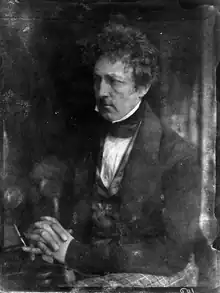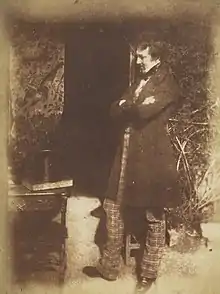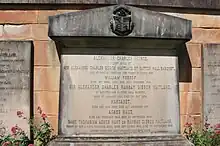John Maitland | |
|---|---|
 John Maitland by Hill & Adamson | |
| Personal details | |
| Born | 17 January 1803 |
| Died | 6 September 1865 |


John Maitland (17 January 1803 - 6 September 1865) filled the position of Accountant to the Court of Session for several years. He took a deep interest in religious schemes, especially those of the Free Church, to which he belonged. He presented to the Free Church the premises in North Bank Street, Edinburgh, occupied by them as a Presbytery hall and mission offices, the only compensation he received being the chambers vacated by them in Frederick Street. In many other respects he was a liberal donor to the schemes of the Free Church; and, as a leading elder, had for many years a seat in the General Assembly of that denomination. Mr Maitland was for a considerable number of years a partner of Mr William Wood. He became a member of the Society of Accountants at its origin in 1853. He was a director of the Commercial Bank of Scotland, and of other public corporations.
Early life
John Maitland was the sixth son of Sir Alexander Gibson Maitland, Baronet of Clifton Hall, county of Edinburgh, he was born on 17 January 1803. When the time came for choosing a profession, he became an accountant in Edinburgh. Latterly he was associated in business with his future brother-in-law, Mr William Wood, C.A., a gentleman of like mind and kindred tastes. Mr Maitland took a deep interest and a very influential part in the organization and development of the National Security Savings Bank. By devising a method whereby all the numerous small accounts of such useful institutions could be brought annually to an exact balance, he solved a difficulty which had previously stood in the way of their success, and made the Edinburgh Savings Bank a model for others throughout the country.[1]
Church leadership
Maitland became a deacon in 1843, and in 1846 an elder, in Free St George’s, Edinburgh, and being thus in the centre of affairs, was enabled to render much effective service.[2] He gave careful thought to the general Sustentation Fund and other financial departments of the Church. He authored several pamphlets, outlining principles of distribution which rendered the Sustentation Scheme successful. This public support seems to have lost him friends, particularly in the upper classes of society, with whom he had been associated by family relationship.[1]
Accountant to the Court of Session
In the year 1850, when the public office of accountant to the Court of Session was created, he was nominated by the Crown to fill it. He filled the position for fifteen years, until the day of his death. His public responsibilities did not preclude the performance of those duties which devolved upon him as a private Christian and an office-bearer in the Church. Although frequently a member of the General Assembly, he was not in the habit of addressing the house.[1]
Other activities
He was a director of the Commercial Bank and of the North British Insurance Company. His also gave his time to numerous other projects for example the Home Mission operations of the Free Church. In the building of churches, of manses, of schools, he took a very warm interest.[1]
Free Church Offices
A few years before his death, Mr Maitland built, in close proximity to the New College, premises for the various offices of the Church. Although the Church handed over to him the former less suitable offices in Frederick Street in part exchange, this gift, erected primarily at his own expense, must have cost him between five and six thousand pounds at nineteenth century value.
Robert Candlish records in his memoirs:
At the meeting of the Commission of Assembly in November, Dr. Candlish adverted to a proposal of Mr. John Maitland, into whose hands the old burned tenement at the head of the Mound had fallen, "to build and fit up premises there, suitable for the offices of the Free Church, and to place them at the disposal of the Church, on no other condition than this, that the proceeds of the sale of our present offices in Frederick Street be handed over to him." It is almost needless to say that Mr. Maitland's very generous offer was gratefully accepted, and in due time the offices of the Church were transferred to the place now occupied by them.[3]
A portrait of Maitland, by Mr Norman Macbeth, was hung the Presbytery Hall; and another portrait, in full length, by Sir John Watson Gordon, was placed in the principal room of the adjoining National Security Savings Bank.[1]
Final illness, death and legacy

Mr Maitland’s last illness was a rapid one, and, as he usually enjoyed good health, and seemed to possess a robust constitution, his death came with sudden and stunning surprise on his numerous friends and the public at large as mentioned in several obituaries.[4][5][2] On Tuesday, 29 August 1865, he attended to his official duties in apparent health. Returning in the afternoon to his residence— that summer at Swinton Bank, near Peebles—he complained of what, for the three following days, appeared to be influenza. On Saturday, however, this illness assumed a more serious aspect; and, with occasional interruptions of his consciousness, he sank beneath the attack, and on Wednesday, 6 September, breathed his last. He was buried in the Grange Cemetery, near the grave of Chalmers, by the north wall.[1] he headstone gives dates which agree with Disruption Worthies rather than the dates in Burke's Peerage. William S. Anderson, College Curator and Office Caretaker, dedicated his A Guide to the Free Church of Scotland College and Offices to John Maitland. It also features Maitland's portrait from the Disruption painting on the front cover showing Maitland holding the plan of the Free Church Offices with Mr David Cousin, the architect. The Guide also has a photograph of Norman MacBeth's painting of Maitland on page 32.[6]
Family
He married Mary Isabella Wood, daughter of John Philip Wood, on 9 November 1852.[7]
References
Citations
Sources
- Anderson, William S. (1994). A Guide to the Free Church of Scotland College and Offices. Edinburgh: Knox Press. ISBN 0904422569.
- Brown, Thomas (1893). Annals of the disruption with extracts from the narratives of ministers who left the Scottish establishment in 1843 by Thomas Brown. Edinburgh: Macniven & Wallace. p. 52.
 This article incorporates text from this source, which is in the public domain.
This article incorporates text from this source, which is in the public domain.
- Burke, Bernard, Sir (1885). Burke's genealogical and heraldic history of the peerage, baronetage, and knightage. Vol. 2. London: Harrison. p. 874.
{{cite book}}: CS1 maint: multiple names: authors list (link)
- Burns, James Chalmers (1858). Memorial of the Late James Maitland Hog, Esq. of Newliston By James C. Burns. Edinburgh: John MacLaren. pp. 72ff.
There are several obituary notices for John Maitland attached just after page 71 of this volume
 This article incorporates text from this source, which is in the public domain.
This article incorporates text from this source, which is in the public domain.
- Hanna, William (1865). The Free Church of Scotland Monthly Record. Edinburgh: Free Church of Scotland. pp. 952-953.
This has all the Monthly Records from 1863 to 1866.
 This article incorporates text from this source, which is in the public domain.
This article incorporates text from this source, which is in the public domain.
- Maclagan, David (1876). St. George's, Edinburgh. London, Edinburgh and New York: T. Nelson and sons. pp. 139-141.
 This article incorporates text from this source, which is in the public domain.
This article incorporates text from this source, which is in the public domain.
- Maitland, John (1845). "The Christian Economy of the Sabbath; or, reasons for the stoppage of work, and railway and other traffic, on the first day of the week". The Christian treasury. Edinburgh: Printed and published by John Johnstone. pp. 587-588.
- Wilson, William, minister of St. Paul's Free Church, Dundee (1880). Memorials of Robert Smith Candlish, D.D. : minister of St. George's Free Church, and principal of the New College, Edinburgh with a chapter on his position as a theologian by Robert Rainy. Edinburgh: A. and C. Black. p. 515.
{{cite book}}: CS1 maint: multiple names: authors list (link) This article incorporates text from this source, which is in the public domain.
This article incorporates text from this source, which is in the public domain.
- Wylie, James Aitken, ed. (1881). Disruption worthies : a memorial of 1843, with an historical sketch of the free church of Scotland from 1843 down to the present time. Edinburgh: T. C. Jack. pp. 389-396.
 This article incorporates text from this source, which is in the public domain.
This article incorporates text from this source, which is in the public domain.